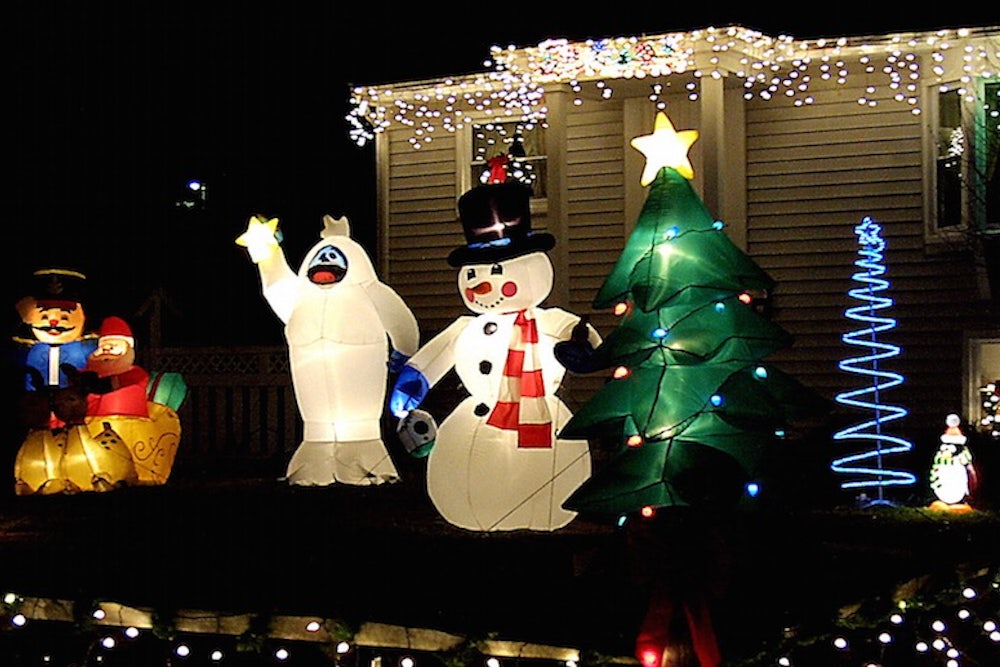Last week, NASA released a report whose tone was misleadingly gleeful. Called "NOAA/NASA Satellite Sees Holiday Lights Brighten Cities," it began, “Even from space, holidays shine bright.” The satellite has been monitoring patterns in nighttime lighting intensity all over the world since its mission began in January of 2012. The conclusions are unsurprising: beginning on Black Friday, nighttime lighting in and around U.S. cities brightens, and remains brighter through New Year’s Day.
That we can observe this from space proves we have too much of a good thing: Our love of holiday lights has become a flagrant waste of energy.
Miguel Román, one of study’s coauthors, told me that they’re waiting for the “happy goldilocks threshold” of three full years of data to make sure the trends they’re seeing are correct, but it doesn't take a scientist to see this—just take a stroll tonight. Of the 70 cities and surrounding suburbs analyzed—all south of St. Louis, because snow in northern cities reflects so much light—Román and his team found that “in most suburbs and outskirts of major cities, light intensity increased by 30 to 50 percent.” Cities saw increases of 20 to 30 percent.


This isn't just a waste of energy, further taxing the environment. It's also contributing to a growing problem in the U.S.: light pollution.
Two years ago, the U.S. Office of Energy Efficiency & Renewable Energy reported that of the eight types of outdoor lighting it studied in 2010—"building exterior, airfield, billboard, railway, stadium, traffic signals, parking and roadway"—over 178 million individual lamps were in use, up from 73 million in 2002. The Astronomical Observatory at Florida Atlantic University has also done extensive research on nighttime lighting. It found that in 2012, more than 35 billion kilowatts per hour (KWh) were used in “estimated wasted outdoor lighting”—considered to be “lights that are on where not needed or where no one is around to use them, on when they are not needed, or are directed upwards where no one can use them”—and it cost consumers $3.4 billion.
It’s possible to estimate the cost of holiday lighting on an individual level—a handful of websites provide calculators. But to get an idea of energy usage and cost increases between Thanksgiving and New Year’s, we’ll have to wait until NASA releases data on the 2014 holiday season, at which point it’s likely that universities and government agencies, not NASA, will study the implications.
Light pollution isn't just wasteful and obnoxious. In a major paper from 1991, two Arizona-based scientists were able to estimate that “30 percent of all outdoor nighttime lighting ends up in the night sky,” which makes it difficult, if not impossible to see phenomena like the Milky Way. Nighttime light exposure has been linked to serious health risks, too: lighting at night suppresses melatonin production and is a "potential risk factor" for breast cancer, and has been linked to obesity.
The Office of Energy Efficiency & Renewable Energy report estimated that as much as 50 percent of nighttime light is used in roadway lighting, but this use hardly enhances safety as well as it we may believe. Research has found that many types of commonly used nighttime roadway lighting are actually distracting and dangerous for nighttime drivers. An interactive feature on FAU’s website shows how nighttime lighting can make it more difficult to see a home intruder – another counterintuitive safety concern.
We have known about the hazards of light pollution for some time now. In 2009, the American Medical Association passed a resolution advocating a reduction in light pollution because of its costs to human health and the environment. So why aren’t we doing anything about it?
Because we're not always logical about our nighttime lighting use. Holiday lights, after all, are as impractical as lights come, but given how ingrained they are in our culture's norms and traditions—to say nothing of their aesthetics, which are more often pleasing than gaudy—they're not likely to wane without government regulation. Look no further than the phase-out of incandescent light bulbs: LED and CFL bulbs are more cost- and energy-efficient, and yet, it took a new law to get Americans to switch. No one’s calling for an all-out ban on electronic Christmas lights and menorahs. But if the economic and environmental arguments against installing an illuminated, life-sized Santa and reindeer on your front lawn aren't convincing enough, maybe the government should compel some restraint.
